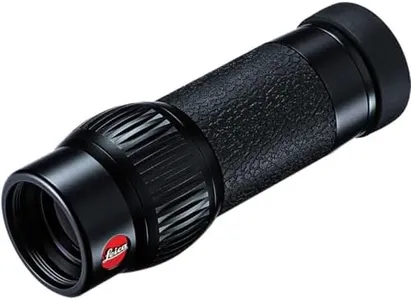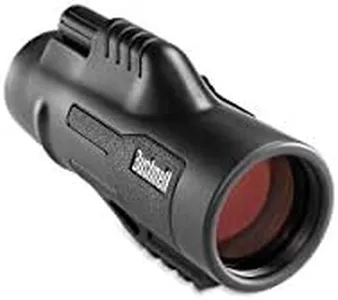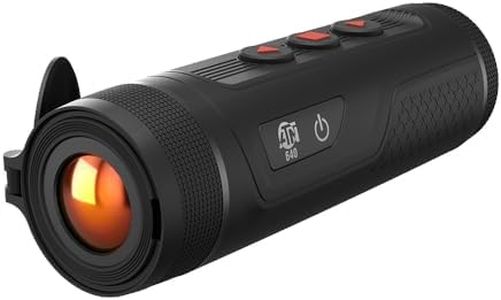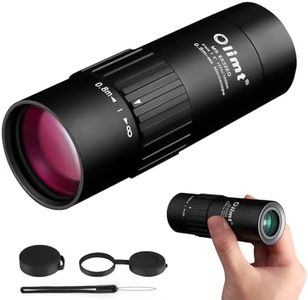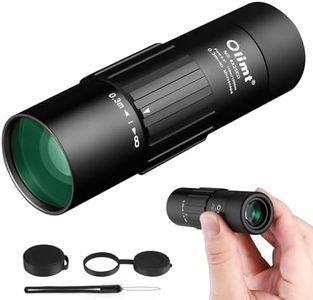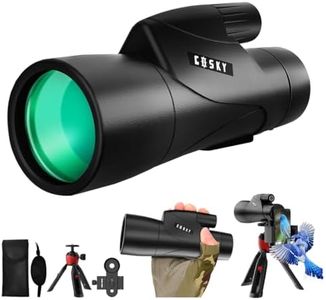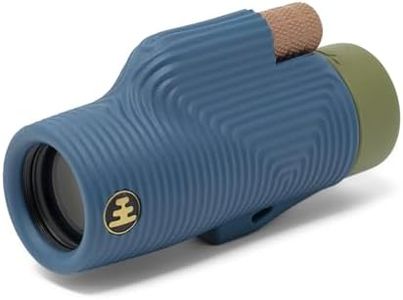10 Best Monoculars 2025 in the United States
Our technology thoroughly searches through the online shopping world, reviewing hundreds of sites. We then process and analyze this information, updating in real-time to bring you the latest top-rated products. This way, you always get the best and most current options available.

Our Top Picks
Winner
Leica Monovid 8 x 20 Monocular with Leather Case (Black)
Most important from
94 reviews
The Leica 8x20 Waterproof Monovid Monocular is a compact and well-built device that caters to outdoor enthusiasts, particularly those interested in activities like hunting or nature observation. With an 8x magnification and an objective lens diameter of 20mm, it offers a decent level of detail and clarity for its size. The waterproof feature, along with a nitrogen-filled construction, ensures the monocular performs well in varied weather conditions, preventing fogging and moisture-related issues. The AquaDura lens coating enhances visibility by repelling water and dirt, making it easier to maintain even in rugged environments.
One of the standout features is its close focusing ability, allowing users to focus on subjects as close as 1.8 meters, or even closer with the included close-up converter lens. This makes it particularly versatile for observing small details in nature or wildlife. The compact size and lightweight design (weighing only 0.9 pounds) make it easy to carry around, fitting comfortably in a pocket or bag.
The 20mm objective lens may limit light-gathering capabilities compared to larger monoculars, which can affect performance in low-light conditions. Additionally, while the central focusing knob is user-friendly, some users may prefer a more precise focusing mechanism. The price point may also be considered high for casual users, as Leica is known for its premium quality. The Leica 8x20 Monovid is a great choice for those who prioritize portability and waterproof features in a monocular. Its close-up capabilities and high build quality make it ideal for serious outdoor enthusiasts, though those needing more powerful magnification or low-light performance may want to explore other options.
Most important from
94 reviews
Pankoo 12x60 HD Monocular Telescope for Adults high Powered | Comes with Smartphone Adapter Tripod Hand Strap | Suitable for Bird Watching Sports Hiking Traveling
Most important from
2113 reviews
The Pankoo 12x60 HD monocular offers a strong 12x magnification with a large 60mm objective lens, which is great for bringing distant views closer while still letting in plenty of light. This means you can see bright and clear images whether you're bird watching, hiking, or at a sports event. The 6.5° wide field of view covers a broad area, making it easier to track moving subjects or enjoy landscape views. Its fully multi-coated lenses and high-quality BAK-4 prism work together to reduce glare and improve image sharpness and color accuracy.
The rubber armor gives it a sturdy, non-slip feel, and the adjustable eyecup helps make viewing comfortable for people who wear glasses or not. At just 14 ounces and compact size, it’s easy to carry around for outdoor activities. Plus, it comes with a smartphone adapter and tripod, allowing you to capture photos through the monocular, which is a fun bonus. This model does not include waterproof or fogproof features, so it may not hold up well in heavy rain or very humid conditions, making it more suitable for fair-weather use.
Manual focusing might require some patience if you’re new to monoculars. If you want a reasonably priced, high-powered monocular for general outdoor use and occasional photography with your phone, this model is a solid choice that balances performance and portability.
Most important from
2113 reviews
Bushnell Legend 10x42 Ultra HD Monocular, Optical Performance for Hunting and Wildlife Observation
Most important from
456 reviews
The Bushnell Legend 10x42 Ultra HD Monocular is a versatile device ideal for hunting and wildlife observation. It offers 10x magnification, which is suitable for various activities like birdwatching and surveillance, providing detailed views of your subject. The 42mm objective lens diameter ensures a wide field of view, and the ED Prime glass with Ultra Wide Band Coating delivers clear, color-accurate images, even in low light conditions. This makes it great for early morning or late afternoon use when wildlife is most active.
The monocular is lightweight at 374 grams, making it portable and easy to carry in your pocket or backpack. Its compact size (5.91 x 3.54 x 3.94 inches) adds to its convenience for on-the-go use. Durability is another strong point, with a rugged, rubber-armored exterior that provides a secure grip. The O-ring sealed optics make it waterproof and fog proof, ensuring reliability in various weather conditions.
The easy focusing system, featuring a smooth focus knob, allows quick adjustments, making it user-friendly. Additionally, the twist-up eyecup offers comfortable viewing for both eyeglass wearers and non-wearers. However, it's worth noting that the monocular is battery-powered and manual focus, which might require some getting used to for those new to such devices. It's also designed for unisex-adult users, making it a versatile option for a wide range of people. Despite being on the market since 2012, it remains a popular choice, ranking well in camera and photo products, thanks to its reliable performance.
Most important from
456 reviews
Buying Guide for the Best Monoculars
Choosing the right monocular can greatly enhance your outdoor experiences, whether you're bird watching, hiking, or attending a sports event. Monoculars are compact and lightweight, making them a convenient alternative to binoculars. To find the best monocular for your needs, it's important to understand the key specifications and how they impact performance. Here are the main specs to consider and how to choose the right one for you.FAQ
Most Popular Categories Right Now


